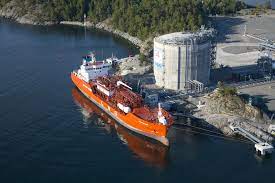Italy aims for ‘miracle’ with LNG project in energy crunch

Piombino: Italy is invoking the need for energy security in the face of Russian supply cuts to rush through in a matter of months a new liquefied natural gas (LNG) terminal – a process that would normally take years due to local objections and permitting.
A preliminary go-ahead for the 5 billion cubic metre capacity (bcm) project in the port of Piombino in the central region of Tuscany, could come as soon as Friday, people close to the matter told Reuters.
Such a big-scale project will help Italy avert a supply crunch it could otherwise face next winter, but keep it hooked on gas for longer, slowing down its transition to renewable energy.

As part of a plan by the outgoing government of Mario Draghi to replace dwindling Russian gas pipeline supplies in the wake of its invasion of Ukraine, Rome has mandated gas grid operator Snam (SRG.MI) to spend around $400 million to set up a new floating storage and regasification unit (FSRU) and have it operational by end-March.
A new rightist government, widely expected to be led by Giorgia Meloni, could be sworn in as soon as next week, with no sign that Rome’s line on Piombino project – endorsed by Italy’s industrial lobby Confindustria – could be changed.
“Our schedule is so tight that each single additional day to approve the project means one day less of gas in our grid,” Elio Ruggeri, the head of Snam’s LNG business, told Reuters.
FSRU is a special ship that receives LNG and transforms it back into natural gas. These vessels have become the market standard for gas needs of up to 10 bcm, as they are quicker to set up and can change locations, Ruggeri said.
Onshore LNG terminals, now normally used for larger needs, take at least three years to be built and Europe’s rush to replace Russian gas with alternative supplies, including LNG, has exposed an acute shortage of processing facilities.

The CEO of energy group Eni (ENI.MI) Claudio Descalzi has warned that, without a new LNG terminal, Italy could face a gas shortfall of 5-6 billion cubic metres, nearly 8% of its annual consumption, in the winter of 2023-24.
The new terminal will help refill the country’s storage system that will run almost empty by the end of this winter and shore up Italy’s energy security, Descalzi said.
Think tank ECCO acknowledges the new LNG terminal is a quick fix that will help over the next winter or two but says it is a “foolish” investment, further tying Italy to an “old” energy source.
“It’s eventually the most expensive choice, increasing the debt burden on new generations,” said Michele Governatori of ECCO. Rather than spend on infrastructure that risks becoming obsolete given Europe’s shifts toward renewable energy, the government could offer incentives to cut energy use and further develop green projects, Governatori said.

With little domestic gas production and a ban on nuclear power generation, Italy heavily relies on imports for its energy needs. Last year, before the Ukraine war, Russian gas covered 38% of its total consumption.
Rome has been quick in securing alternative supplies, but with pipeline deliveries of Azeri and Algerian gas already at their limits, it needs LNG to fully replace Russian imports.
Italy has focused on its decades-long relationships with Africa and as a result of efforts of state-controlled Eni it expects additional LNG imports for more than 8 bcm by next winter, two sources said.
The supplies, mainly from African nations, including Algeria, Angola, Congo Republic, Egypt and Mozambique as well as Qatar and the United States, are due to reach over 10 bcm in the 2024-2025, they said.
Since new volumes cannot fit in Italy’s three existing LNG terminals, Piombino, a second newly-acquired FRSU that Snam plans to set up in 2024 and an already planned ramp-up of one of the existing terminals will have to absorb the new flows.
Piombino’s port, which links the mainland with the Elba island, a popular holiday destination, will allow an easy transport of gas to the densely populated and industrialised north of Italy.
Its mayor, a member of Meloni’s party, has led local protest against the project, stressing risks for safety, environment and local businesses, including fish-farming.
However Draghi’s government has appointed a special commissioner and granted him sweeping powers that will allow the project to proceed even if challenged in court.
The commissioner, Tuscany president Eugenio Giani, is holding talks with Snam, local authorities, the National health institute and other bodies to address specific concerns.
Some local and environmental grassroots associations and unions gathered in Piombino on Thursday for a rally against the project.
Snam says it will need a final go-ahead from him by end-October to meet the end-March deadline.
That would mean just four months from the initial request, “nearly a miracle” in a country where infrastructure projects take years to get approved, one source said.
Snam has agreed to keep the FSRU docked in Piombino for three years and to move it to a yet unspecified off-shore location afterwards.
Rome could end up granting a discount on gas price of up to 50% for businesses and households in Piombino to allay local concerns and secure support for the project, the commissioner said.





